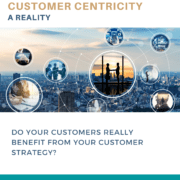Top 5 Obstacles to B2B Customer Centricity # 3 Silo’d Organisation
The Top Five Obstacles to Customer Centricity in B2B Companies and How to Overcome them
Obstacle 3: Silo’d Organisation
This is the third blog in our series based on the early results of research undertaken by Peter Lavers on customer centricity.
“My company is organised in silos; customer programmes are championed by functions, which find it hard to influence other parts of the business”
 Scroll down to take part in our survey.
Scroll down to take part in our survey.
For many of us this statement describes a painful reality. Here are just two reasons why silos affect B2B customer experience:
- I often encounter staff having objectives that are for the benefit of the silo rather than the company as a whole – effectively creating unhealthy competition because collaboration is made painfully hard. Have you ever heard a colleague say “Why should I help you meet YOUR objectives at the expense of MY bonus?!”
- This issue leads to finger pointing and blame culture. It’s always easier to blame someone in a different silo. Sometimes this even gets out to the customers! I have too often listened to conversations in which an account team member blames another part of the business for the customer’s predicament. This is a lose-lose situation!
It’s insular and uncollaborative behaviour that does so much counter-cultural damage to becoming more customer focused as a business. In other words it’s about people, and we all know that people don’t like change.
In order to address this issue we DON’T necessarily need another reorganisation! We need something that everyone can align to that adds up to success for the customer as well as the different functions within the organisation – however they’re structured.
My sorely missed recently deceased colleague Doug Leather, defined customer centricity in this way:
“Customer Centricity is the eco-system and operating model
that enables an organisation to design and deliver
a unique and distinctive customer experience”
I would agree and assert that taking a systemic approach to Customer Management is the fundamental solution to the ‘silo’ problem. A light bulb moment for me was when feeding back to an automotive business. I said to them “if you engineered your customer experience with the same quality approach as your cars, you would have much happier customers”. They agreed!
What is systemic thinking?
Study.com defines it as:
“A system is a set of parts that interact and affect each other, hereby creating a larger complex whole. System thinking is a method of critical thinking by which you analyse the relationships between the system’s parts in order to understand a situation for better decision-making”.
The analogy of a tree as part of a forest is often cited as a good example of a system. A forest doesn’t just consist of trees! It is interdependent with plants, fungi, insects, animals & birds. A change to any one part of the system will have some effect on all other parts.
Please note the words in orange – systems thinking is all about making better decisions. It is not marketing “fluff” and definitely not the IT system!
Systemic thinking isn’t new in business. We do not expect components to arrive at a production line, or cash to be in ATMs, by accident. There’s a complex, quality managed, business system behind them. This then begs the question:
Does your customer experience happen by accident?
If it does – or if it’s so disconnected it’s not recognisable as a system – then your company is exposed to unnecessary risk and you need your own systemic model to align around.
In B2B it’s all about long-term relationship quality.
We use different systemic models for B2C, B2B, Public Sector and Not For Profit (NFP).
- Consolidation in the sector has made it critical to effectively manage relationships with key accounts, partners, brokers, suppliers and distributors.
- The Customer Attuned model is such a business system. Customer relationships are based on trust and working together for mutual commercial benefit.
- The model joins up all the capabilities required to go to market, manage relationships and organise yourselves from knowledge & insight through strategy, planning, implementation and measurement.
Find out much more about this model and the best practices of B2B customer management in The Golden Threads Customer Management eBook, which is available here for free.
Summary
- Do you hear talk of “empires” or “Republic of” within your business? If so then there’s a silo problem and those in leadership need to take up their responsibilities to drive customer centricity from the top.
- Every company has different issues and is starting from its own unique position. We can help you this thinking to benefit both your customers and your staff.
I hope that this blog has done a little to inspire you to be agents of positive change towards customer centricity.
By Peter Lavers
It’s not too late to take part – if you would like to include your views then please complete our short survey to tell us what, if anything, you are pulling your hair out over when it comes to customer centricity.
It is easy to complete – just 10 statements to agree or disagree with. Please click here: Obstacles to Customer Centricity
Tweet to @customerattune Tweet to @PeterLavers
Read part one here: Numbers Focus
Read part two here: Multi-channel Journey//
- The Customer Attuned “Infinity Loop” of Customer Centricity Explained - December 8, 2023
- Protected: Partnership Survey 2023 Results - July 11, 2023
- Truth Loyalty Webinar with Peter Lavers - July 7, 2021




